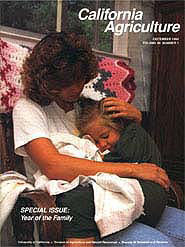


University of California
California Agriculture
|
|||
|
|||

Special Issue: Year of the Family
Cover:
In California, 13% suffer from stark hunger; 57% of single mothers and one in four children live below the poverty line. Photo by Suzanne Paisley
December 1994
Volume 48, Number 7 News and opinion |
|||
|
University of California, 1301 S. 46th St., Bldg. 478 Richmond, CA
|